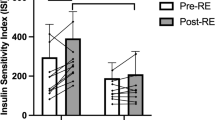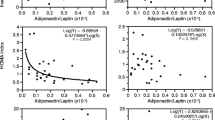Abstract
Purpose
Obesity may attenuate metabolic health improvements following lifestyle interventions. However, the effect of adiposity on insulin action following resistance exercise in young non-diabetic women is unknown. The purpose of this study was to test the hypothesis that adiposity attenuates improvements in insulin sensitivity and glucose-stimulated insulin secretion (INS0–60/GLC0–60) after both acute resistance exercise (ARE) and progressive training (PRT).
Methods
Twenty-six young non-diabetic women (21.2 ± 0.7 years) were randomly assigned to control (C; n = 7; BF 40.1 ± 2.1 %) or exercise groups: normal body fat (NBF; n = 8; BF 29.9 ± 2.3 %) and high body fat (HBF; n = 12; BF 48.2 ± 1.4 %). Acute whole-body exercises were performed at 60 % of 1-RM for three sets of 8–12 repetitions, and PRT was performed 3 days/week for 7 weeks. A 75 g OGTT was conducted before and after ARE and PRT to estimate insulin sensitivity (Matsuda index) and INS0–60/GLC0–60. Insulin area under the curve (AUC) was calculated using the trapezoidal model.
Results
ARE had no statistical effect on insulin action across groups. Strength and fat-free mass (via DXA) increased after PRT in both NBF and HBF (p < 0.05), but only HBF women decreased BF (p < 0.01). HBF women were less insulin sensitive at baseline compared to NBF women (p < 0.05). Insulin sensitivity increased 95 % and INS0–60/GLC0–60 decreased 32 % following PRT in NBF, but not HBF or C (p < 0.05). After training, enhanced insulin sensitivity was inversely related to decreased INS0–60/GLC0–60 (r = −0.71, p < 0.001), fasting insulin (r = −0.71, p < 0.001), and insulin AUC (r = −0.85, p < 0.001).
Conclusion
Seven weeks of PRT increases insulin sensitivity and reduces glucose-stimulated insulin secretion in NBF, but not HBF women. Obesity attenuates exercise-induced improvements in glucose regulation in young non-diabetic women.

Similar content being viewed by others
References
Abdul-Ghani M, Tripathy D, DeFronzo R (2006) Contributions of β-cell dysfunction and insulin resistance to the pathogenesis of impaired glucose tolerance and impaired fasting glucose. Diabetes Care 29:1130–1139
Anderwald C, Gastaldelli A, Tura A et al (2011) Mechanism and effects of glucose absorption during an oral glucose tolerance test among females and males. J Clin Endocrinol Metab 96:515–524
Baechle TR, Earle RW (2008) Essentials of strength training and conditioning. Human Kinetics, Champaign
Balkau B, Mhamdi L, Oppert J et al (2008) Physical activity and insulin sensitivity: the RISC study. Diabetes 57:2613
Bingley CA, Gitau R, Lovegrove JA (2008) Impact of menstrual cycle phase on insulin sensitivity measures and fasting lipids. Horm Metab Res 40:901–906
Black SE, Mitchell E, Freedson PS, Chipkin SR, Braun B (2005) Improved insulin action following short-term exercise training: role of energy and carbohydrate balance. J Appl Physiol 99:2285
Blake D, Meigs J, Muller D, Najjar S, Andres R, Nathan D (2004) Impaired glucose tolerance, but not impaired fasting glucose, is associated with increased levels of coronary heart disease risk factors: results from the Baltimore longitudinal study on aging. Diabetes 53:2095–2100
Bouchard C, Blair SN, Church TS, Earnest CP, Hagberg JM, Hakkinen K, Jenkins NT, Karavirta L, Kraus WE, Leon AS, Rao DC, Sarzynski MA, Skinner JS, Slentz CA, Rankinen T (2012) Adverse metabolic response to regular exercise: is it a rare or common occurrence? PLoS ONE 7:e37887
Cheng Y, Gregg E, De Rekeneire N et al (2007) Muscle-strengthening activity and its association with insulin sensitivity. Diabetes Care 30:2264–2270
Church T, Blair S, Cocreham S et al (2010) Effects of aerobic and resistance training on hemoglobin A1c levels in patients with type 2 diabetes: a randomized controlled trial. JAMA 304:2253–2262
Cuff DJ, Meneilly GS, Martin A, Ignaszewski A, Tildesley HD, Frohlich JJ (2003) Effective exercise modality to reduce insulin resistance in women with type 2 diabetes. Diabetes Care 26:2977–2982
De Filippis E, Alvarez G, Berria R et al (2008) Insulin-resistant muscle is exercise resistant: evidence for reduced response of nuclear-encoded mitochondrial genes to exercise. Am J Physiol Endocrinol Metab 294:E607–E614
DeFronzo R, Abdul Ghani M (2011) Preservation of β-cell function: the key to diabetes prevention. J Clin Endocrinol Metab 96:2354–2366
DeFronzo R, Matsuda M (2010) Reduced time points to calculate the composite index. Diabetes Care 33:e93–e93
Despres JP, Lemieux I, Prud’homme D (2001) Treatment of obesity: need to focus on high risk abdominally obese patients. BMJ 322:716–720
Fenicchia LM, Kanaley JA, Azevedo JL et al (2004) Influence of resistance exercise training on glucose control in women with type 2 diabetes. Metabolism 53:284–289
Fluckey JD, Hickey MS, Brambrink JK, Hart KK, Alexander K, Craig BW (1994) Effects of resistance exercise on glucose tolerance in normal and glucose-intolerant subjects. J Appl Physiol 77:1087–1092
Heilbronn L, Gan S, Turner N, Campbell L, Chisholm D (2007) Markers of mitochondrial biogenesis and metabolism are lower in overweight and obese insulin-resistant subjects. J Clin Endocrinol Metab 92:1467–1473
Heyward VH (2002) Advanced fitness assessment and exercise prescription. Human Kinetics, Champaign
Holten MK, Zacho M, Gaster M, Juel C, Wojtaszewski JFP, Dela F (2004) Strength training increases insulin-mediated glucose uptake, GLUT4 content, and insulin signaling in skeletal muscle in patients with type 2 diabetes. Diabetes 53:294–305
Hurlbut DE, Lott ME, Ryan AS et al (2002) Does age, sex, or ACE genotype affect glucose and insulin responses to strength training? J Appl Physiol 92:643–650
Ibanez J, Gorostiaga E, Alonso A et al (2008) Lower muscle strength gains in older men with type 2 diabetes after resistance training. J Diabetes Complicat 22:112–118
Ishii T, Yamakita T, Sato T, Tanaka S, Fujii S (1998) Resistance training improves insulin sensitivity in NIDDM subjects without altering maximal oxygen uptake. Diabetes Care 21:1353–1355
Jenkins N, Hagberg J (2011) Aerobic training effects on glucose tolerance in prediabetic and normoglycemic humans. Med Sci Sports Exerc 43:2231–2240
Kahn SE, Prigeon RL, McCulloch DK et al (1993) Quantification of the relationship between insulin sensitivity and β-cell function in human subjects. Evidence for a hyperbolic function. Diabetes 42:1663–1672
Karelis A, Fontaine J, Messier V et al (2008) Psychosocial correlates of cardiorespiratory fitness and muscle strength in overweight and obese post-menopausal women: a MONET study. J Sports Sci 26:935–940
Krishnan RK, Hernandez JM, Williamson DL, O’Gorman DJ, Evans WJ, Kirwan JP (1998) Age-related differences in the pancreatic β-cell response to hyperglycemia after eccentric exercise. Am J Physiol 275:E463–E470
Layne A, Nasrallah S, South M et al (2011) Impaired muscle AMPK activation in the metabolic syndrome may attenuate improved insulin action after exercise training. J Clin Endocrinol Metab 96:1815–1826
Malin SK, Kirwan JP (2012) Fasting hyperglycaemia blunts the reversal of impaired glucose tolerance after exercise training in obese older adults. Diabetes Obes Metab 14:835–841
Metcalfe R, Babraj J, Fawkner S, Vollaard NBJ (2012) Towards the minimal amount of exercise for improving metabolic health: beneficial effects of reduced-exertion high-intensity interval training. Eur J Appl Physiol 112:2767–2775
Miyazaki Y, Akasaka H, Ohnishi H, Saitoh S, DeFronzo R, Shimamoto K (2008) Differences in insulin action and secretion, plasma lipids and blood pressure levels between impaired fasting glucose and impaired glucose tolerance in Japanese subjects. Hypertens Res 31:1357–1363
Nilsson M, Greene N, Dobson J et al (2010) Insulin resistance syndrome blunts the mitochondrial anabolic response following resistance exercise. Am J Physiol Endocrinol Metab 299:E466–E474
Potteiger J, Claytor R, Hulver M et al (2011) Resistance exercise and aerobic exercise when paired with dietary energy restriction both reduce the clinical components of metabolic syndrome in previously physically inactive males. Eur J Appl Physiol 112(6):2035–2044
Reed M, Ben Ezra V, Biggerstaff K, Nichols D (2012) The effects of two bouts of high- and low-volume resistance exercise on glucose tolerance in normoglycemic women. J Strength Cond Res 26:251–260
Samuel V, Shulman G (2012) Mechanisms for insulin resistance: common threads and missing links. Cell 148:852–871
Schmitz K, Ahmed R, Yee D (2002) Effects of a 9-month strength training intervention on insulin, insulin-like growth factor (IGF)-I, IGF-binding protein (IGFBP)-1, and IGFBP-3 in 30–50-year-old women. Cancer Epidemiol Biomarkers Prev 11:1597–1604
Stickland NC, Batt RA, Crook AR, Sutton CM (1994) Inability of muscles in the obese mouse (ob/ob) to respond to changes in body weight and activity. J Anat 184:527–533
Thamer C, Machann J, Stefan N et al (2007) High visceral fat mass and high liver fat are associated with resistance to lifestyle intervention. Obesity 15:531–538
Walton C, Godsland IF, Proudler AJ, Felton CV, Wynn V (1992) Effect of body mass index and fat distribution on insulin sensitivity, secretion, and clearance in nonobese healthy men. J Clin Endocrinol Metab 75:170–175
Yeung E, Zhang C, Mumford S et al (2010) Longitudinal study of insulin resistance and sex hormones over the menstrual cycle: the BioCycle Study. J Clin Endocrinol Metab 95:5435–5442
Acknowledgments
BJE conceptualized the study, and SKM, KRH, BGE, and TKE contributed to study design. All authors shared aspects of data collection, analysis, and interpretation. SKM, KRH and TKE share responsibility for statistical integrity. SKM and KRH wrote the manuscript and remaining authors provided edits. We thank Dr. Donovan Conley from Wayne State and Dr. Barry Braun from the University of Massachusetts for their advice on study design, as well as Shana Erwin and the Wayne Mercy Medical Center Lab Staff for clinical testing. We also thank Summer Cord and Kevin Negaard at the Center for Neurosciences, Orthopaedics & Spine for DXA assistance. We lastly thank all subjects for their efforts. This study was funded by the Wayne State College Foundation.
Conflict of interest
The authors have no conflict of interest.
Author information
Authors and Affiliations
Corresponding author
Additional information
Communicated by Peter Krustrup.
S. K. Malin and K. R. Hinnerichs shared first author responsibilities.
Rights and permissions
About this article
Cite this article
Malin, S.K., Hinnerichs, K.R., Echtenkamp, B.G. et al. Effect of adiposity on insulin action after acute and chronic resistance exercise in non-diabetic women. Eur J Appl Physiol 113, 2933–2941 (2013). https://doi.org/10.1007/s00421-013-2725-5
Received:
Accepted:
Published:
Issue Date:
DOI: https://doi.org/10.1007/s00421-013-2725-5




